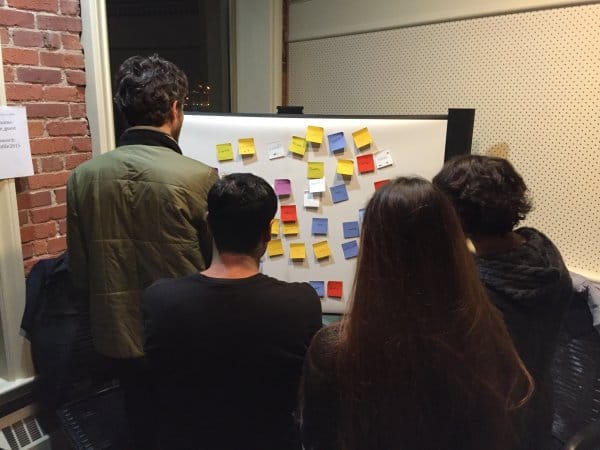Planning Stakeholder Engagement, Part 1: Getting Started
I love facilitating gatherings for stakeholder engagement. It’s a key part of the Deep Listening phase in our methodology. When we talk about Deep Listening, it really means understanding what internal and external stakeholders are thinking about. Stakeholder engagement is a very necessary part of our methodology of Deep Listening. By listening deeply we can uncover root causes, motivations, and expected behavior that lends itself well to building any kind of future endeavor.
My role often entails listening for — and helping clients avoid — potential blind spots. Persona work is one of the best ways to get around them But personas are most effective when they are developed from research in the field.
Let’s discuss what I see as important questions around stakeholder engagement. The most important aspect to deep listening is finding out each stakeholder’s objectives. Are you looking for confirmation of a direction or perhaps insight into a behaviour? Getting to a deeper understanding of the motivations and behavior of the stakeholders is often a valuable objective. It helps unearth and uncover issues that my clients might not be aware of. We feel it is part of our responsibility to make sure that we’ve dug into the issues and have a clear understanding of what will work going forward.
Question #1 – Who should we plan to engage?
Taking the time to thoughtfully understanding who we need to talk to is the first step of planning engagement. Often times clients have a good understanding of who this would be. However a common problem is the attempt to engage too many groups at once, which leads to superficial engagement After identifying potential stakeholders, we then work together to identify the most insightful stakeholder group. In a recent project, we decided to talk to the stakeholders that were directly affected by the work we were doing even though another larger group of people would be indirectly affected. It’s always better to start with groups that are the closest to the objective.
Question #2 – What are our constraints?
Once the most strategic group of people is identified, it’s important to determine other forces that will influence the campaign’s potential. Often, constraints like budget and timelines come into play. I often wish clients would come to us earlier in their process so that we might have a longer run at recruiting the right stakeholders. But in reality, project timelines come fast and often have fixed dates that need to be adhered to. Even with a smaller budget, the right group can be engaged creatively. Just one focus group or community consultation can achieve a lot.

Question #3 – What should the format be?
In-person facilitation is always conducive to relationship-building, but sometimes a virtual session is just as effective. In a recent round of consultations, we interviewed over 150 people. At least half of them were virtual. This enabled geographic reach that would have been impossible to achieve via in-person meetings (without a large travel budget and a longer time frame). Typically, virtual meetings are good for broad stroke community consultations. We pair our virtual presentations with an online survey that is administered immediately afterwards. This is a pretty effective tool for ensuring a consistent kind of feedback and allows easier comparison of feedback. The in-person facilitations allow a deeper and more thoughtful investigation because as a facilitator, I can “read” the room and dig into things that I notice (as body language can show contradictions in what they are saying, which I can then ask about.) While a virtual session can be an hour, usually in-person discussions run for two to three hours. Of course, being in-person, these sessions require more work to pull off, not only with logistics, but also paying close attention around the psychology and dynamics of a group.
Question #4 – What should the recruitment process be?
This can sometimes be fairly straightforward but it can also be quite complex. One of our best practices involves creating a high level picture of the type of person we developed in the first step of identifying stakeholders. Based on this, we develop a process to recruit and vet them. Building a simple form can often be successful, combined with writing a draft email that my client can send to their membership, stakeholder list, or what have you. Sometimes we need to recruit from the general public, and that’s where we can advertise on places like craigslist or a community newspaper. The majority of participants come from the organization and their network. Knowing that typically it’s appropriate to compensate people with a small honorarium, we figure this out before recruitment.
Once these four questions are answered, we are prepared to run the facilitation session. This involves a fair amount of logistics and planning. It’s important to consider the context of the group you are engaging when deciding on details like location, date and time. For example, university students are freer during the day, but board members might need to have sessions after work or on the weekend. I prefer arranging sessions with meals so that we have a chance to actually spend time together before getting down to work. Work with many vulnerable communities, we also do our best to make room for inclusivity providing bus tickets, food and even potentially arranging rides to the location.
I hope this is giving you a high level understanding of how facilitation can occur. Of course, all of this definitely hinges on getting the right facilitator that can help you with this process. If you are looking for a consultation process for your next project, whether online or more strategic, feel free to contact us. My next blog will cover how to run a facilitation and get the best results.

